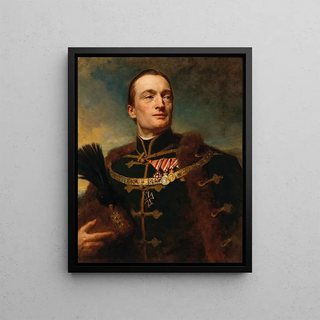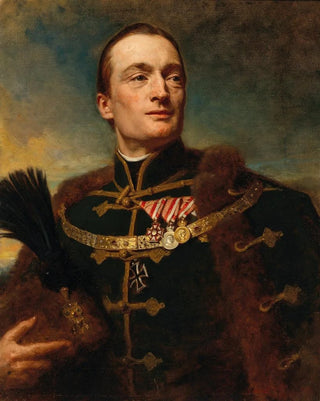Art print | Portrait of an officer - Gyula Benczúr


View from behind

Frame (optional)
The "Art print Portrait of an officer" by Gyula Benczúr is an iconic piece that captures not only the essence of the subject depicted but also the spirit of an era. This painting, rich in detail and emotion, evokes a personal story while fitting into a broader historical context. Benczúr's technical mastery, combined with his artistic sensitivity, makes this portrait a must-have for anyone interested in art and human representation. As you contemplate this work, the viewer is invited to immerse themselves in a universe where each brushstroke tells a story, where every shadow and light blend to bring to life a character whose gaze seems to transcend time.
Style and uniqueness of the work
Benczúr's style is characterized by striking realism, where meticulous details combine with a rich and nuanced color palette. In "Portrait of an officer," the artist manages to capture not only the physical features of his model but also their character and status. The textures of fabrics, the shine of medals, and the finesse of accessories demonstrate scrupulous attention to detail. The officer's posture, solemn and dignified, evokes a sense of duty and honor, values dear to the era in which Benczúr created this work. This portrait is not limited to a simple representation; it becomes a true declaration of the subject's identity, a reflection of their time, and an exploration of universal themes of power and responsibility.
The artist and his influence
Gyula Benczúr, a major figure in 19th-century Hungarian art, mastered the balance between tradition and modernity in his creations. Trained in the ateliers of great European masters, he developed a personal style that allowed him to stand out in the artistic landscape of his time. His work is marked by a deep understanding of pictorial techniques, as well as an ability to convey complex emotions through his portraits. Benczúr also played a key role in training many artists, sharing his knowledge and expertise. His contribution to art history extends beyond his works, influencing generations of artists and shaping the artistic scene of his era.

Matte finish

View from behind

Frame (optional)
The "Art print Portrait of an officer" by Gyula Benczúr is an iconic piece that captures not only the essence of the subject depicted but also the spirit of an era. This painting, rich in detail and emotion, evokes a personal story while fitting into a broader historical context. Benczúr's technical mastery, combined with his artistic sensitivity, makes this portrait a must-have for anyone interested in art and human representation. As you contemplate this work, the viewer is invited to immerse themselves in a universe where each brushstroke tells a story, where every shadow and light blend to bring to life a character whose gaze seems to transcend time.
Style and uniqueness of the work
Benczúr's style is characterized by striking realism, where meticulous details combine with a rich and nuanced color palette. In "Portrait of an officer," the artist manages to capture not only the physical features of his model but also their character and status. The textures of fabrics, the shine of medals, and the finesse of accessories demonstrate scrupulous attention to detail. The officer's posture, solemn and dignified, evokes a sense of duty and honor, values dear to the era in which Benczúr created this work. This portrait is not limited to a simple representation; it becomes a true declaration of the subject's identity, a reflection of their time, and an exploration of universal themes of power and responsibility.
The artist and his influence
Gyula Benczúr, a major figure in 19th-century Hungarian art, mastered the balance between tradition and modernity in his creations. Trained in the ateliers of great European masters, he developed a personal style that allowed him to stand out in the artistic landscape of his time. His work is marked by a deep understanding of pictorial techniques, as well as an ability to convey complex emotions through his portraits. Benczúr also played a key role in training many artists, sharing his knowledge and expertise. His contribution to art history extends beyond his works, influencing generations of artists and shaping the artistic scene of his era.






